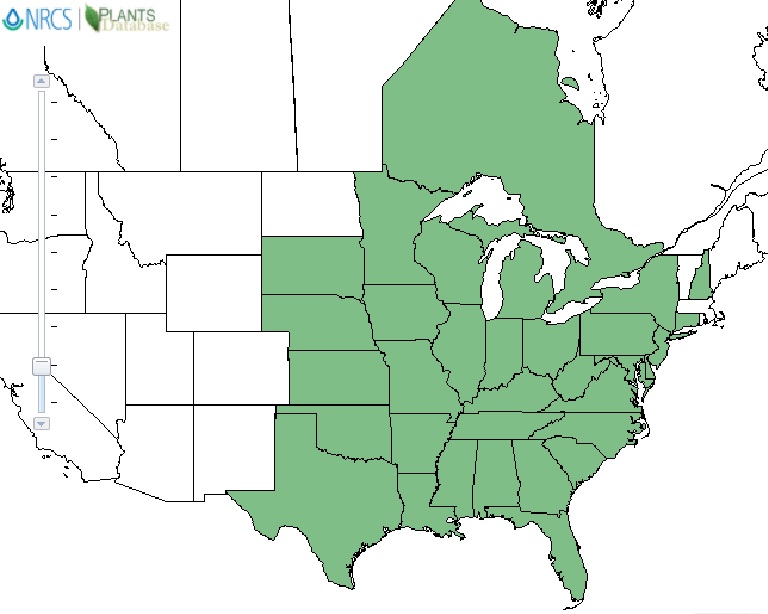Smilax hispida
| Smilax hispida | |
|---|---|

| |
| Photo by John Hilty hosted at IllinoisWildflowers.info | |
| Scientific classification | |
| Kingdom: | Plantae |
| Division: | Magnoliophyta - Flowering plants |
| Class: | Liliopsida - Moncots |
| Order: | Liliales |
| Family: | Smilacaceae |
| Genus: | Smilax |
| Species: | S. hispida |
| Binomial name | |
| Smilax hispida Rafinesque | |

| |
| Natural range of Smilax hispida from Weakley. Natural range of Acer rubrum from USDA NRCS Plants Database. | |
Common Name: bristly greenbriar[1][2]
Contents
Taxonomic Notes
Synonym: S. tamnoides; S. tamnoides 'var. hispida (Muhlenberg) Fernald
Varieties: S. hispida var. hispida; S. hispida var. australis
Description
Smilax hispida is a monoecious perennial that grows as a shrub or vine.[2] As a vine, it frequently climps 30-45 ft (9.1-13.7 m) into trees has internodes on the main stem 4-10 in (10.2-25.4 cm) apart. Stems are usually very prickly.[3] In central eastern Illinois, it averages 13 stems and its seeds have a mean mass of 23.690 mg.[4]
Distribution
This species ranges from Connecticut, New York, Minnesota, and Nebraska south to Texas and southern Florida.[1][2][5]
Ecology
Habitat
S. hispida is found in moist to wet forests.[1] On southern Ohio burned oak forests, the mean frequency ranged between 5.2-6.7% of plots between 1995 and 1999.[6]
Fire ecology
Both solitary (burned once) and recurring (biennial) burns reduced the average percent cover of S. hispida on a red and white pine mixed plantation in Kalamazoo County, Michigan during 1991-1995.[7]
Conservation and Management
Cultivation and restoration
Photo Gallery
References and notes
- ↑ 1.0 1.1 1.2 Weakley AS (2015) Flora of the Southern and Mid-Atlantic States. Chapel Hill, NC: University of North Carolina Herbarium.
- ↑ 2.0 2.1 2.2 USDA NRCS (2016) The PLANTS Database (http://plants.usda.gov, 23 January 2018). National Plant Data Team, Greensboro, NC 27401-4901 USA.
- ↑ Schaffner JH (1931) Characteristic examples of accumulative progressive evolutionary movements: Studies in determinate evolution, V. Ohio Journal of Science 31(5):346-367.
- ↑ Michaels HJ, Benner B, Hartgerink AP, Lee TD, Rice S, Willson MF, Bertin RI (1988) Seed size variation: magnitude, distribution, and ecological correlates. Evolutionary Ecology 2:157-166.
- ↑ Zhao Y, Qi Z, Ma W, Dai Q, Li P, Cameron KM, Lee J, Xiang Q, Fu C (2013) Comparative phylogeography of Smilax hispida group (Smilacaceae) in eastern Asia and North America - Implications for allopatric speciation, causes of diversity disparity, and origins of temperate elements in Mexico. Molecular Phylogenetics and Evolution 68:300-311.
- ↑ Hutchinson T (2005) Fire and the herbaceous layer of eastern oak forests. Proceedings of Fire in Eastern Oak Forests: Delivering science to land managers. Nov 15-17, 2005, Columbus, OH. USDA Forest Service, General Technical Report NRS-P-1, pp. 136-149
- ↑ Neumann DD, Dickmann DI (2001) Surface burning in a mature stand of Pinus resinosa and Pinus strobus in Michigan: effects on understory vegetation. International Journal of Wildland Fire 10:91-101.